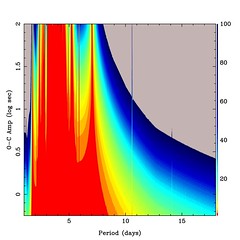There are about a dozen exosolar planets that transit their host star (a transit is when the planet moves in front of the star blocking out light). Measuring the when transits occur can be a powerful tool to determine if other planets are present in that system.
The Figure above shows a simulation of transit timings if additional planets are present. The primary planet has a mass of 0.69 times the Jupiter and an orbital period of approximately 3.52 days. The colours indicate the mass of secondary planet, ranging from 1 to 100 times the mass of the Earth. The scale on the bottom shows the period of the secondary planet ranging from 1 to 17 days. The scale on the left indicates the change in the occurrence of the transit event. It is a log scale (0 -> 1 sec, 1 -> 10 sec, 2-> 100 sec and so on..).
Long term monitoring of transiting systems gives the opportunity to possibly discover other Earth-sized planets outside out Solar System.
Monday, January 28, 2008
Subscribe to:
Post Comments (Atom)

No comments:
Post a Comment